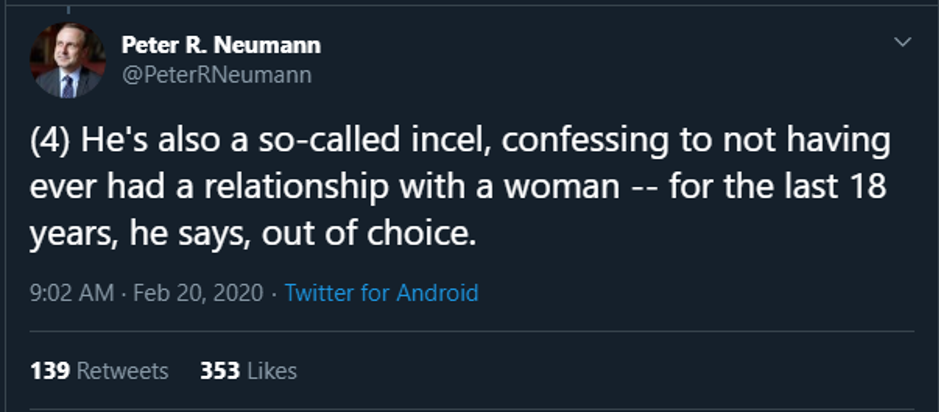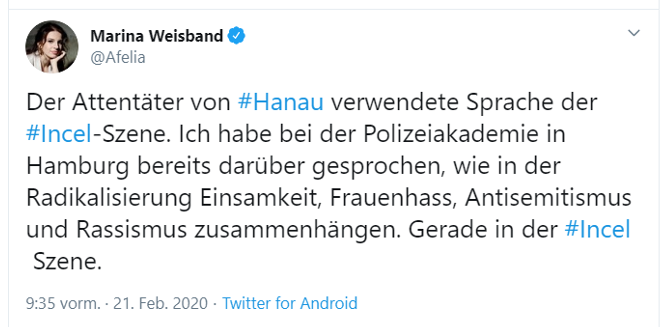On the evening of February 19th, a shooter opened fire at a shisha bar and a kiosk in Hanau, Germany killing nine people and injuring more. After the attack, the suspect apparently returned to his home, killed his mother, and committed suicide. He shared a manifesto detailing the racist and supremacist background of the attack. While the main focus of much of the coverage in German and international media has been the perpetrator’s blatant far-right and xenophobic motivations, several articles have focused on the misogyny present in the manifesto by the Hanau shooter.
While this connection between white supremacy, anti-Semitism, and anti-feminism is new to the German discussion, it gained increased attention in international media after several recent attacks in North America. Since 2014, a number of attacks have been committed by men motivated by resentment at their lack of romantic or sexual relationships, the core of a misogynist ideology that has developed through online “incel” (“involuntarily celibate”) communities that also tend toward conspiracy theories and nihilism. Earlier in 2019, anti-feminism and anti-Semitic conspiracy theories also played a role in the far-right terrorist attack in Germany targeting a synagogue in Halle. The shooter blamed low birth rates in the West on feminism, intertwining this with a perceived threat from mass immigration, a common conspiracy theory known as the “Great Replacement”.
As scholars working on different aspects of male supremacism, we appreciate the new focus and attentiveness that is given in the broader media landscape to the significance of gender and misogyny in relation to (right-wing) extremist attacks. However, there are certain caveats we would like to share regarding the ways in which incels were discussed in the wake of the Hanau shooting, with some media outlets quick to term the perpetrator an incel. There is a danger of trivializing the relevance of how misogyny, male entitlement, and white supremacy are deeply linked within a violent belief system.
Discussing incels after the Hanau shooting
The manifesto written by the shooter is riddled with conspiracist thinking and misogyny. Multiple pages within the 24-page manifesto are titled ‘Topic Women.’ The attacker highlights his frustration with women, stating he had not been in a relationship for the last 18 years. This, leading scholars and journalists to engage with his misogyny. With a high demand for information about the shooter and his motivations in the immediate aftermath of the attack, several articles and Twitter threads quickly labelled him as an incel. But the terminology of misogyny and how it shapes online groups is more complex than has been portrayed in various media outlets.
“The attacker from #Hanau used language from the #Incels-Scene. I already spoke at the Police Academy in Hamburg about how radicalization, loneliness, hatred of women, Anti-Semitism and racism are related. Especially in the #Incel scene.”
The term incel was originally coined by a Canadian bisexual woman in the 1990s, who created Alanna’s Involuntary Celibate Project, a website for “anybody of any gender who was lonely, had never had sex or had not had a relationship in a long time.” At this time, incel membership was not exclusively comprised of heterosexual cisgender men. The connotation of the term changed as it became associated with more misogynist forums, and was linked to several deadly attacks by men connected to these spaces and the concept of incel identity. PUAHate.com—one of the most significant early forums used by incels—was created for men who had attempted but failed to seduce women using Pick-Up Artist (PUA) techniques. Such techniques—also known as ‘game’, ‘seduction’, or ‘sex strategy’—had been popularized by the 2007 Neil Strauss book The Game. They detail ways to manipulate women into sexual contact, some of which cross the line to sexual assault and/or rape. Their popularity contributed to a broader development of online spaces for sexually frustrated men, including those that rejected PUA manipulation/seduction techniques. In May of 2014, one member of these forums, published a manifesto and several YouTube videos detailing his motivation before killing six people in Isla Vista, California. His reasoning was rooted in male sexual entitlement, hatred of women, and frustration with his involuntary celibacy. The attack brought the idea of ‘inceldom’ in its new, misogynistic iteration a first wave of public attention and led to the identity’s association with violent extremism.
Their own forums define an incel as someone who has attempted to, but has remained unable to be in a romantic relationship. Many incels believe that their unluckiness in obtaining a romantic relationship can be attributed to a combination of their looks and feminism, which they blame for women’s ‘high standards’ for a relationship and for a society generally hostile to men. An increasing number of academics have engaged with online incel narratives and fora. Studies have exposed how they are based on a toxic cycle of victimization and misogyny which leaves no room for challenging oppressive male and female gender roles. In the 2014 Isla Vista attack, the perpetrator set out to “punish all females for the crime of depriving me of sex.” He decided to target a sorority—viewing the women who lived there as the kind of women he wanted but could never have (during the attack, he was thwarted in his attempt to gain entry to the building). His desire to punish all women for his (involuntary) celibacy speaks to a belief that women owe men sex and attention, and that men are entitled to women and their bodies. Today on incel forums, posters share stories of rejection from women. In many cases, these stories of rejection are cited as the reason that the poster considers themselves to be an incel, or when they became aware of their status as an incel.
More recent deadly attacks in Roseburg, Oregon, in 2015, and in Toronto, Canada and Tallahassee, Florida, in 2018 reignited interest and public awareness of incels. In 2019, the FBI warned filmgoers of possible threats of violence connected to “incel extremists” at screenings of the film Joker. The film has been labelled an “incel training manual” and criticized as a sympathetic portrayal of the radicalization of a mass killer. However, this increased attention has arguably not yet given the public a better understanding of what an incel is or what they believe.
Misogynist cultures online - incels and the Manosphere
While deep-seated misogyny and feelings of sexual entitlement were certainly present in the Hanau manifesto, as well as in manifestos of the incel killers of Toronto and Tallahassee, misogyny per se should not be used as evidence that the Hanau attacker was an incel. Blanket-labelling any violent misogynist as incel does not help when we are trying to understand misogyny and its potentially deadly consequences. Misogyny and sexual entitlement, while present in both incel forums and in the manifesto, are much more far-reaching—both throughout broader society, and online cultures.
A prominent manifestation of this is the so-called ‘Manosphere’. The ‘Manosphere’ is a conglomerate of misogynist blogs, websites, wikis, and forums that currently includes several broader groups: Next to the aforementioned incels and pickup artists (i.e. men who try to manipulate and seduce women), there are also men’s rights activists (who claim to advocate for the rights of fathers, divorced men, and men falsely accused of sexual assault). They are deeply anti-feminist and focus on exposing the ‘evils’ of feminism to justify their misogyny. Another prominent group is that of Men Going Their Own Way (MGTOW). MGTOW intend to have as little contact with women as possible and postulate an independent, seemingly self-sufficient lifestyle. They openly disdain women, and normalize it through online harassment.
While they are different in expression, all manifestations of the manosphere share a hostile sexism, perpetuating Heterosexism, and reinforcing negative, restrictive gender stereotypes that position genders in hierarchies to one another. Sometimes used as an umbrella term for the core belief of many of these streams is the concept of The Red Pill and its related discussion boards. Being “redpilled” has become a popular male and white supremacist term for awakening to a previously hidden “truth” of the world—mainly the evils caused by feminism, or general liberal thought. Lastly, there are also male supremacists who are not associated with one of these organized ideologies; just like “white supremacy”, “male supremacy” is an overarching belief system.
Misogyny in the Hanau shooter's manifesto
The manifesto of the Hanau shooter, besides being filled with racist and conspiratorial tropes, is riddled with misogynistic remarks. While some are reminiscent of incel talking points, the manifesto does not demonstrate a clear connection to the incel identity, either in terms of evidence that the shooter frequented incel forums or shared basic incel ideology.
In the section ‘Topic Women’, the shooter writes that every human has the desire not to be alone, to find the right partner, and that the unfulfillment of this desire hinders joy and accomplishments. The latter part of this—the desire but inability to find a romantic partner—fits with the incel narrative. However, he details that he did not have a girlfriend because of his extremely high standard for women and his assessment that very few met these standards. By stating that he could have had relationships with less attractive women, but wanted the "best or nothing," the perpetrator deviates from incel ideology. He has also been denominated as MGTOW. MGTOW, however, try intentionally to separate themselves from women and blame—again—women and feminism for the need to stay alone as an act of self-preservation. But different from the MGTOW worldview, the shooter named an imagined surveillance as a reason for staying single. The shooter's manifesto, with its eclectic mix of racist, conspiratorial, and misogynist tropes, does not fit neatly into the groups of the Manosphere.
Nevertheless, the Hanau Manifesto does demonstrate misogyny and male supremacism. The entitlement of not wanting to settle for anything ‘but the best’ shows a sexist, objectifying view of women. This perspective is common throughout online misogynist forums, for which male sexual entitlement is a belief that cuts across all the various ideologies. Categorizing people—men and women alike—into a sexual hierarchy is a classic trope across misogynist online groups. Incels typically consider themselves at the bottom of this hierarchy in current society, but still feel themselves entitled to women’s bodies, while other groups are trying to ‘improve’ their place within this hierarchy through financial success or physical fitness.
However, the idea of male entitlement goes far beyond the realms of the ‘manosphere’. In mainstream discourse, ‘Nice Guy’ and ‘friendzone’ narratives feed into this same sense of entitlement. The idea that women owe men sex or a relationship because they were ‘nice’ to women, befriended women, or showed basic human decency towards women speaks to how entrenched entitlement to women is among men. Male anger at women for saying no to a date, sex, or an interaction on the street is something that pervades societies around the globe. This misogynistic sexual entitlement lies not just in the far corners of the internet, or in the manifestos of terrorists, but in our streets and in the daily lives of women. This is evidenced by the testimony shared by survivors of sexual assault and harassment in the wake of #metoo, which detail accounts of many whose careers, mental health, and personal safety had been restricted through unwanted sexual advances. In an even more horrifying vein, this societal tendency is also evident in a continuous occurrence of violent attacks against women who rejected the sexual advances of men. Women have been killed for saying no to a date for the prom, ignoring catcalls, and for not wanting to share their name and phone number.
Conspiracies, white supremacy, and misogyny: an unholy alliance
In addition to misogynist entitlement, the Hanau manifesto exudes stark paranoia and references conspiracy theories ranging from assertions of secret bunkers in the United States to a conviction that he is one of the few people who notices that he is being surveilled by an ominous secret agency. Common for conspiracist beliefs, he imagines himself to have access to ‘secret knowledge’. Secret knowledge or ‘seeing the world as it truly is’ is a common aspect that unites misogynist and far-right sub-groups, and lays a foundation for shared beliefs and identities—including ‘The Red Pill’.
Due to their shared tendency towards conspiratorial thinking, misogynist online forums in general and incel forums in particular are often considered a recruiting ground for the far-right. Some prominent figures have transgressed the so-called ‘Manosphere’ to become misogynist far-right figureheads—incorporating their misogyny into their far-right agitation. Male and white supremacist groups share a narrative of victimhood of (white) men in a society that they perceive as being stacked against them. Women, feminists, liberals, and some form of ‘shadowy elite’ are then blamed for this self-perceived victimhood. This elite is also often thought to be Jewish.
Anti-Semitic conspiracies in both far-right and misogynist groups are prevalent, and occasionally their conspiracies overlap. In 2017, a leaked “style guide” of the Neo-Nazi website The Daily Stormer revealed one instance of this overlap: “women should be attacked, but there should always be mention that if it wasn’t for the jews they would be acting normally.” Several articles from The Daily Stormer demonstrate how their authors follow these guidelines, referring to feminism always as Jewish feminism or to feminism as a “Jewish Invention” that has hurt women and shaped their behavior. In the case of the Hanau attack, some incel commenters suspected an anti-Semitic conspiracy theory, claiming the shooting was “(((set up))).” These three parentheses are an anti-Semitic symbol popularized by the alt-right that is used to highlight Jewish names and organizations.
It is important to better understand just how exactly anti-Semitism, white, and male supremacist groups cross-fertilize with one another; and while their connections must be kept in mind and further analyzed, male supremacy should be taken seriously on its own as well.
Incel and far-right reaction to the Hanau shooting
Incels often react to the association of acts of mass violence with inceldom by celebrating attackers as 'saints' or 'heroes.' They speculate whether killers are incel based on their physical appearances and targets. Following the Toronto attack, incel hubs on platforms such as Reddit almost doubled in subscriber numbers, and recent studies have found migration to more extreme and increasingly violent forums.
At the same time, some members of the incel community interpret media reports that an attacker was an incel as a perpetuation of them being scapegoated. Inceldom centers around the concept of victimization, mainly related to ‘not being understood’ or ‘seen’ by others. When someone is labelled an incel without evidence, some incels claim this as further proof that they are at the bottom of a perceived societal and sexual hierarchy and therefore will be blamed for all of society's ills. In the case of Hanau, discussions on the main incel-boards have largely revolved around how the framing of the attack is another case of incels being wrongly blamed. Users on one incel thread claimed that the shooter could not have been incel because he drove a BMW, which would elevate him too high in their imagined social hierarchy.
Incels instead have asserted that the Hanau attacker was likely mentally ill, the same response given by the far-right party AfD (Alternative for Germany). As with white supremacist attacks, media often play into portraying male supremacist terrorist attacks as related to mental illnesses, even though terrorism scholars have long denounced mental health as a useful causal factor and predictor for violent extremism. This risks ostracizing people with mental disorders even further and diverts attention from the ideologies behind these attacks.
What we should learn from Hanau
The labeling of the Hanau attacker as ‘incel’ is problematic in several regards. First, as we have shown, not all violent misogynists are ‘incels’. The misattribution of the attack to one particularly known sub-group of the manosphere risks feeding into the incel narrative of unjustified societal victimization and at the same time provides them with a new wave of curious potential followers. Moreover, it can harm proper analysis. To avoid overly simplistic (or plain inaccurate) labelling, we therefore suggest ‘male supremacism’ as the more fitting label for the misogynist motivation of attacks like Hanau.
Second, and potentially more harmful is the media framing of inceldom as simultaneously exotic and ‘weird’ as well as potentially dangerous. The focus on incels as strange outcasts of ‘normal’ society tends to obscure that misogyny and male supremacism do not originate in and are not exclusive to obscure corners of the internet. Misogyny—like racism—has always been a part of our societies. It has always been violent, with misogynist terrorism, rape, and intimate partner violence as just the tip of an iceberg of persistent male entitlement. It goes much deeper into the realms of sexual harassment, gender pay gaps, and daily life practices that still put child rearing, un(der)paid care labor, and household work squarely as the responsibilities of women.
Accurate labelling of the ideologies at stake is one element required for a deeper understanding of the societal dynamics and issues on which the success of extremist groups of all couleur are built. In order to avoid trivializing how deeply misogyny, male entitlement, and white supremacy remain entrenched in our societies, we have to go past any simplistic use of the incel-label. Instead we must continue to ask the hard questions: how and why it seems so intuitive to some young men to connect anti-Semitism, racism, and misogyny into a worldview that—in their view—demands violent activism?
This article represents the views of the author(s) solely. ICCT is an independent foundation, and takes no institutional positions on matters of policy unless clearly stated otherwise.
Photocredit: 55Ohms/Shutterstock










